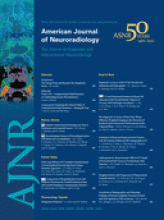Wernicke encephalopathy is a syndrome that is caused by thiamine deficiency and characterized by the triad of ophthalmoplegia, ataxia, and confusion, with short-term memory loss. It typically begins with ataxia, followed in a few days or weeks by mental confusion. Additionally, there may be a simultaneous onset of ataxia, nystagmus, and ophthalmoplegia with or without confusion. Less often, 1 component of the triad may be the sole manifestation.1 The incidence of Wernicke encephalopathy has fallen significantly in the alcoholic population; however, it is being recognized with increasing frequency among nonalcoholic patients in a variety of clinical settings, mainly iatrogenic ones. Bilateral blindness has been observed to occur during the course or even as the initial symptom,2⇓–4 but bilateral deafness has rarely been reported.5 Here, we report a patient whose first symptom was acute bilateral deafness during the treatment of acute pancreatitis.
A 23-year-old man presented at the emergency department with acute abdominal pain. He had no history of alcoholism. He was quickly diagnosed with acute pancreatitis, and his diet was then strictly limited for approximately 1 month. On day 31, his parents found he did not answer their questions unless they spoke very loudly. Shortly after, he said the world became “completely silent, ” though others were talking. This symptom lasted for 2 days, and then he felt severe tinnitus in both ears. On the morning of day 33, he felt diplopia, but he still had normal orientation. By the afternoon of that day, the patient became confused and spoke in an unintelligible manner, prompting a neurologist consultation. Neurologic examination revealed a global confusional state. He was apathetic, inattentive, and indifferent to his surroundings. Spontaneous speech was minimal, and many questions were left unanswered. At times, the patient drifted off to sleep, though he could be aroused without difficulty.
The neuro-ophthalmologic picture was complex: He presented prominent exotropia due to severe bilateral oculomotor palsy and spontaneous vertical or sometimes rotational nystagmus. His pupils were large and sluggish in responding to light. Additionally, he presented with cerebellar ataxia with bilateral intention tremor on both arms and legs, whereas there was no rest tremor. He could not stand upright, with eyes open or shut. The bilateral Babinski sign was absent. Blood examination showed normal kidney function and normal levels of the following: liver enzyme, serum glucose, inflammatory markers, and electrolytes. Serum thiamine could not be determined owing to a lack of techniques and instruments at the hospital. MR imaging of his brain demonstrated signal-intensity changes in the bilateral inferior colliculi, superior colliculi, bilateral posteromedial thalamus, and bilateral inferior cerebellar peduncles on diffusion-weighted or T2-weighted imaging (Fig 1).
Brain MR diffusion-weighted imaging demonstrates symmetric hyperintensities in the bilateral inferior colliculi (A and B), posteromedial thalamus (D and E), and mammillary bodies (C). MR imaging with T2-weighting demonstrates hyperintensity in bilateral inferior cerebellar peduncles (F).
In view of his dietary limitation due to pancreatitis, diagnosis of Wernicke encephalopathy was considered, and a daily dose of 200-mg thiamine was empirically administered intravenously and continued during the next weeks. Two days after treatment, his symptoms (including deafness, diplopia, and mental disturbance) began to ameliorate. One week later, his gait disorder improved steadily. He was discharged from the emergency department after 3 weeks of thiamine injection and continued to take an oral thiamine tablet for a month.
To our knowledge, this is a rare case of Wernicke encephalopathy that began with bilateral deafness. As shown in Fig 1, there are obvious abnormal signals at the inferior colliculi of the midbrain on diffusion-weighted imaging, in addition to the abnormalities in the bilateral thalamus, inferior cerebellar peduncles, and mammillary bodies.
The daily thiamine requirement for healthy individuals is related to their carbonate intake and is between 1 and 2 mg per day. Because the body stores are only between 30 and 50 mg, it might be anticipated that this would be depleted in 4–6 weeks.6 A patient should be supplemented with thiamine if he or she cannot have a normal diet for longer than 1 week. This case is iatrogenic, and clinicians should know these important symptoms that herald Wernicke encephalopathy to avoid a potentially fatal result.
References
- © 2012 by American Journal of Neuroradiology








